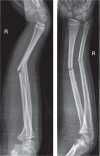Conversion to below-elbow cast after 3 weeks is safe for diaphyseal both-bone forearm fractures in children
- PMID: 24171685
- PMCID: PMC3822135
- DOI: 10.3109/17453674.2013.850010
Conversion to below-elbow cast after 3 weeks is safe for diaphyseal both-bone forearm fractures in children
Abstract
Background: It is unclear whether it is safe to convert above-elbow cast (AEC) to below-elbow cast (BEC) in a child who has sustained a displaced diaphyseal both-bone forearm fracture that is stable after reduction. In this multicenter study, we wanted to answer the question: does early conversion to BEC cause similar forearm rotation to that after treatment with AEC alone?
Children and methods: Children were randomly allocated to 6 weeks of AEC, or 3 weeks of AEC followed by 3 weeks of BEC. The primary outcome was limitation of pronation/supination after 6 months. The secondary outcomes were re-displacement of the fracture, limitation of flexion/extension of the wrist and elbow, complication rate, cast comfort, complaints in daily life, and cosmetics of the fractured arm.
Results: 62 children were treated with 6 weeks of AEC, and 65 children were treated with 3 weeks of AEC plus 3 weeks of BEC. The follow-up rate was 60/62 and 64/65, respectively with a mean time of 6.9 (4.7-13) months. The limitation of pronation/supination was similar in both groups (18 degrees for the AEC group and 11 degrees for the AEC/BEC group). The secondary outcomes were similar in both groups, with the exception of cast comfort, which was in favor of the AEC/BEC group.
Interpretation: Early conversion to BEC cast is safe and results in greater cast comfort.
Figures
References
-
- Arnould C, Penta M, Renders A, Thonnard JL. ABILHAND-Kids: a measure of manual ability in children with cerebral palsy . Neurology. 2004;63(6):1045–52. - PubMed
-
- Bhaskar AR, Roberts JA. Treatment of unstable fractures of the forearm in children. Is plating o... . J Bone Joint Surg (Br) 2001;83(2):253–8. - PubMed
-
- Bochang C, Jie Y, Zhigang W, Weigl D, Bar-On E, Katz K. Immobilisation of forearm fractures in children: extended versus flexed ... . J Bone Joint Surg (Br) 2005;87(7):994–6. - PubMed
-
- Boero S, Michelis MB, Calevo MG, Stella M. Multiple forearm diaphyseal fracture: reduction and plaster cast control... . Int Orthop. 2007;31(6):807–10. - PMC - PubMed
-
- Chan CF, Meads BM, Nicol RO. Remanipulation of forearm fractures in children . N Z Med J. 1997;110(1047):249–50. - PubMed
Publication types
MeSH terms
LinkOut - more resources
Full Text Sources
Other Literature Sources
Medical
Miscellaneous


